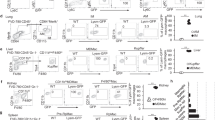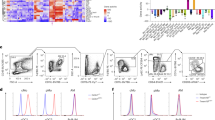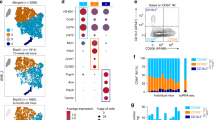Abstract
Monocytes and macrophages comprise a variety of subsets with diverse functions1,2,3,4,5. It is thought that these cells play a crucial role in homeostasis of peripheral organs, key immunological processes and development of various diseases. Among these diseases, fibrosis is a life-threatening disease of unknown aetiology. Its pathogenesis is poorly understood, and there are few effective therapies. The development of fibrosis is associated with activation of monocytes and macrophages6,7,8. However, the specific subtypes of monocytes and macrophages that are involved in fibrosis have not yet been identified. Here we show that Ceacam1+Msr1+Ly6C−F4/80−Mac1+ monocytes, which we term segregated-nucleus-containing atypical monocytes (SatM), share granulocyte characteristics, are regulated by CCAAT/enhancer binding protein β (C/EBPβ), and are critical for fibrosis. Cebpb deficiency results in a complete lack of SatM. Furthermore, the development of bleomycin-induced fibrosis, but not inflammation, was prevented in chimaeric mice with Cebpb−/− haematopoietic cells. Adoptive transfer of SatM into Cebpb−/− mice resulted in fibrosis. Notably, SatM are derived from Ly6C−FcεRI+ granulocyte/macrophage progenitors, and a newly identified SatM progenitor downstream of Ly6C−FcεRI+ granulocyte/macrophage progenitors, but not from macrophage/dendritic-cell progenitors. Our results show that SatM are critical for fibrosis and that C/EBPβ licenses differentiation of SatM from their committed progenitor.
This is a preview of subscription content, access via your institution
Access options
Subscribe to this journal
Receive 51 print issues and online access
$199.00 per year
only $3.90 per issue
Buy this article
- Purchase on Springer Link
- Instant access to full article PDF
Prices may be subject to local taxes which are calculated during checkout




Similar content being viewed by others
References
Asano, K. et al. CD169-positive macrophages dominate antitumor immunity by crosspresenting dead cell-associated antigens. Immunity 34, 85–95 (2011)
Auffray, C. et al. Monitoring of blood vessels and tissues by a population of monocytes with patrolling behavior. Science 317, 666–670 (2007)
Kohyama, M. et al. Role for Spi-C in the development of red pulp macrophages and splenic iron homeostasis. Nature 457, 318–321 (2009)
Okabe, Y. & Medzhitov, R. Tissue-specific signals control reversible program of localization and functional polarization of macrophages. Cell 157, 832–844 (2014)
Swirski, F. K. et al. Identification of splenic reservoir monocytes and their deployment to inflammatory sites. Science 325, 612–616 (2009)
Duffield, J. S., Lupher, M., Thannickal, V. J. & Wynn, T. A. Host responses in tissue repair and fibrosis. Annu. Rev. Pathol. 8, 241–276 (2013)
Sica, A., Invernizzi, P. & Mantovani, A. Macrophage plasticity and polarization in liver homeostasis and pathology. Hepatology 59, 2034–2042 (2014)
Wynn, T. A., Chawla, A. & Pollard, J. W. Macrophage biology in development, homeostasis and disease. Nature 496, 445–455 (2013)
Sheel, M. & Engwerda, C. R. The diverse roles of monocytes in inflammation caused by protozoan parasitic diseases. Trends Parasitol. 28, 408–416 (2012)
Tsukui, T. et al. Qualitative rather than quantitative changes are hallmarks of fibroblasts in bleomycin-induced pulmonary fibrosis. Am. J. Pathol. 183, 758–773 (2013)
Yáñez, A., Ng, M. Y., Hassanzadeh-Kiabi, N. & Goodridge, H. S. IRF8 acts in lineage-committed rather than oligopotent progenitors to control neutrophil vs monocyte production. Blood 125, 1452–1459 (2015)
Arinobu, Y., Iwasaki, H. & Akashi, K. Origin of basophils and mast cells. Allergol. Int. 58, 21–28 (2009)
Li, Y., Qi, X., Liu, B. & Huang, H. The STAT5–GATA2 pathway is critical in basophil and mast cell differentiation and maintenance. J. Immunol. 194, 4328–4338 (2015)
Nei, Y. et al. GATA-1 regulates the generation and function of basophils. Proc. Natl Acad. Sci. USA 110, 18620–18625 (2013)
Scheller, M. et al. Altered development and cytokine responses of myeloid progenitors in the absence of transcription factor, interferon consensus sequence binding protein. Blood 94, 3764–3771 (1999)
Gutknecht, M. F. & Bouton, A. H. Functional significance of mononuclear phagocyte populations generated through adult hematopoiesis. J. Leukoc. Biol. 96, 969–980 (2014)
Terry, R. L. & Miller, S. D. Molecular control of monocyte development. Cell. Immunol. 291, 16–21 (2014)
Yona, S. et al. Fate mapping reveals origins and dynamics of monocytes and tissue macrophages under homeostasis. Immunity 38, 79–91 (2013)
Auffray, C. et al. CX3CR1+CD115+CD135+ common macrophage/DC precursors and the role of CX3CR1 in their response to inflammation. J. Exp. Med. 206, 595–606 (2009)
Hettinger, J. et al. Origin of monocytes and macrophages in a committed progenitor. Nat. Immunol. 14, 821–830 (2013)
Satoh, T. et al. Critical role of Trib1 in differentiation of tissue-resident M2-like macrophages. Nature 495, 524–528 (2013)
Satoh, T. et al. The Jmjd3-Irf4 axis regulates M2 macrophage polarization and host responses against helminth infection. Nat. Immunol. 11, 936–944 (2010)
Hanna, R. N. et al. The transcription factor NR4A1 (Nur77) controls bone marrow differentiation and the survival of Ly6C− monocytes. Nat. Immunol. 12, 778–785 (2011)
Tanaka, T. et al. Targeted disruption of the NF-IL6 gene discloses its essential role in bacteria killing and tumor cytotoxicity by macrophages. Cell 80, 353–361 (1995)
Tanaka, T., Yoshida, N., Kishimoto, T. & Akira, S. Defective adipocyte differentiation in mice lacking the C/EBPβ and/or C/EBPδ gene. EMBO J. 16, 7432–7443 (1997)
Omori, Y. et al. Mef2d is essential for the maturation and integrity of retinal photoreceptor and bipolar cells. Genes Cells 20, 408–426 (2015)
Aoyama, K., Takagi, T., Hirase, A. & Miyazawa, A. STEM tomography for thick biological specimens. Ultramicroscopy 109, 70–80 (2008)
Kremer, J. R., Mastronarde, D. N. & McIntosh, J. R. Computer visualization of three-dimensional image data using IMOD. J. Struct. Biol. 116, 71–76 (1996)
Acknowledgements
We thank S. Saeki, S. Watanabe, R. Takenaka and M. Miyamoto for assistance with experiments, and T. Matsuki, T. Kawasaki, H. Kanemaru, H. Tanaka and K. Kuniyoshi for helpful discussions. We thank T. Kitamura for providing PlatE cells. We also thank E. Kamada for secretarial assistance, and C. Funamoto, N. Kitagaki, A. Wataki, K. Yokoyama and R. Kawaguchi for technical assistance. This work was supported by the Government of Japan and the Japan Society for the Promotion of Science (JSPS) through the funding program for World-Leading Innovative R&D on Science and Technology (FIRST Program), by Japan Science and Technology Agency (JST) thorough funding for a Grant-in-Aid for Young Scientists (A)(16H06234), Specially Promoted Research (15H05704) and the US National Institutes of Health (P01-AI070167) and ‘Visionary Research Fund’ from Takeda Science Foundation. A part of this work was supported by the Nanotechnology Platform (project number 12024046) of the Ministry of Education, Culture, Sports, Science and Technology (MEXT), Japan.
Author information
Authors and Affiliations
Contributions
T.S. designed and performed the experiments and wrote the manuscript. K.F., I.E., F.Y. and A.K. helped with experiments. K.N. performed the experiments. M.A. and Y.M. performed bioinformatics analysis. F.S. and Y.Y. performed the MRI analysis. R.K. performed the electron microscopy analysis. S.A. wrote the manuscript and supervised the project.
Corresponding author
Ethics declarations
Competing interests
S.A. has research support from Chugai Pharmaceutical Co., Ltd. The terms of this arrangement have been reviewed and approved by the Osaka University in accordance with its policy on objectivity in research.
Additional information
Reviewer Information Nature thanks I. Amit, D. Brenner, F. Geissmann and the other anonymous reviewer(s) for their contribution to the peer review of this work.
Extended data figures and tables
Extended Data Figure 1 Characterization of various macrophage/monocytes.
a, Indicated cell types were sorted and RNA was collected from them. Each cell type was subjected to microarray analysis. Principal component analysis by using gene expression data was performed. b, c, Indicated cell types in bone marrow were sorted, and each cell type was adoptively transferred into the wild-type mice, which were administered bleomycin. Images of Azan staining (b) and quantity of hydroxyproline are shown (c). Similar results were obtained in three independent experiments (a–c). Scale bars, 100 μm. *P < 0.05, **P < 0.01.
Extended Data Figure 2 Cebpb−/− chimaeras are resistant to the development of fibrosis.
a, Quantity of hydroxyproline 14 days after bleomycin administration was determined. b, Indicated cytokines in the BAL 3 days after bleomycin administration were determined by ELISA. c, d, Images of H&E staining in the lung tissue 4 days (c) and 13 days (d) after intratracheal injection with bleomycin. Scale bars, 50 μm. e, MRI imaging, H&E, Azan and Sirius red staining of lung. f, MRI images of T2 weighted (T2W), T1 weighted (T1W) and water suppression (WS) was shown (left panels). Azan staining of fibrotic lungs and corresponding schematic images of fibrotic region (right panels). g, Indicated cell types in bone marrow were sorted, and adoptively transferred into the wild-type mice with bleomycin administration. Quantity of hydroxyproline was shown. Similar results were obtained in three independent experiments (a–g). *P < 0.05, **P < 0.01.
Extended Data Figure 3 Cebpd is dispensable for fibrosis and SatM differentiation.
a, The survival rate of chimaeras (at least n = 5) inoculated with bleomycin (3 μg per g body weight). Similar results were obtained in three independent experiments. b, The proportions of SatM in bone marrow (upper left panel), spleen (bottom left panel), blood (upper right panel) and lung (bottom right panel) were shown. Similar results were obtained in five independent experiments.
Extended Data Figure 4 Modified high-fat diet liver fibrosis was repressed in Cebpb−/− chimaeras.
a, Liver was collected from wild-type and Cebpb−/− chimaeric mice fed on CDA-HFD, and indicated mRNA were determined by qPCR. b, Images of Azan staining of liver tissue. Scale bar, 50 μm. c, Quantity of hydroxyproline was determined. Similar results were obtained in three independent experiments (a–g). *P < 0.05, **P < 0.01.
Extended Data Figure 5 Wound healing progressed normally in Cebpb−/− chimaeras.
a, b, Chimaeric mice with wild-type and Cebpb−/− cells (at least n = 5) were injured by biopsy (diameter (Φ) = 6 mm). The repair rate of the wound area was monitored. c, H&E analysis of skin was performed. Similar results were obtained in three independent experiments.
Extended Data Figure 6 FACS analysis of various immune cells in Cebpb−/− chimaeras.
a, FACS analysis of spleen. The proportions of neutrophils (upper left), eosinophils (middle left), natural killer cells (bottom left), B cells, T cells (upper right), plasmacytoid dendritic cells (pDC) and conventional dendritic cells (cDC) were shown. b, FACS analysis of SatM. The proportions of these cells in blood (left panel), spleen (centre panel) and lung (right panel) were shown. Similar results were obtained in five independent experiments (a, b).
Extended Data Figure 7 Initiation factor of fibrosis produced from activated SatM.
a, Sorted SatM were cultured with Toll-like receptor ligands for 48 h, and concentrations of indicated cytokines were determined by ELISA. b, Fibroblasts were cultured with TNF-α for indicated time, and expression level of Spp1 mRNA was determined by qPCR. Similar results were obtained in three independent experiments (a, b). *P < 0.05, **P < 0.01.
Extended Data Figure 8 Characterization of SatM.
a, The FSC–SSC profiles of whole-cell and SatM in bone marrow (left and centre panels) and merged image (right panel) were shown. Similar results were obtained in three independent experiments. b, Expression of phosphorylated (p-) and unphosphorylated Erk and Akt and actin in SatM stimulated with M-CSF (50 ng ml−1). c, Flow cytometric analysis of spleen. The proportions of SatM were shown by F4/80−, Mac1+, Ly6C−, Msr1+ and Ceacam1+. Similar results were obtained in five independent experiments (b, c). d, The expression level of indicated cell surface molecules of SatM from bone marrow were shown. Similar results were obtained in three independent experiments. e, Cell lysates were prepared from SatM in wild-type mice, and were subjected to whole-cell proteomics analysis. Substantially expressed granule proteins were described. f, g, Sorted Siglec-F+CCR3+CD4− population, Ly6G+Mac1+ population and DX5+FcεRI+c-kit−CD3−CD19− population were stained with Diff-Quick after cytospin centrifugation and were photographed (f) and investigated by TEM (g). Scale bars were shown in indicated images. Similar results were obtained in three independent experiments (f, g). h, Flow cytometric analysis of spleen obtained from wild-type and ΔdblGATA mutant mice. The proportions of eosinophils (upper panel) and SatM (bottom panel) were shown. Similar results were obtained in five independent experiments.
Extended Data Figure 9 Characterization of various progenitors.
a, The proportion of GMPs (left panel) and MDPs (right panel) were shown. Similar results were obtained in three independent experiments. b, Sorted Ly6C−FcεRI+ GMP population were stained with Diff-Quick after cytospin centrifugation and were photographed. Similar results were obtained in five independent experiments. c, Principal component analysis by using gene expression of indicated cells was performed. d, SatM, inflammatory monocytes, SMPs, cMoPs, MDPs and GMPs were sorted and subjected to microarray analysis. Data on transcription factor genes were partitioned by k-means clustering using the threshold k = 8. Clustered molecules are shown. e, Sorted GFP+Lin–c-kit–C5aR+CD115+FcεRI+Ly6C– populations were transferred into wild-type mice, and then analysed by FACS. Similar results were obtained in three independent experiments.
Extended Data Figure 10 Macrophages regulated by Jmjd3 and Trib1 were dispensable for the development of fibrosis.
a, The proportion of SatM in Jmjd3−/− (left panel) and Trib1−/− (right panel) were shown. Similar results were obtained in five independent experiments. b, c, Chimaeric mice with wild-type, Jmjd3−/− or Trib1−/− haematopoietic cells (at least n = 5) were intratracheally inoculated with bleomycin (3 μg per g body weight). The survival rate of mice was monitored (b). Images of Azan staining for collagen fibres in the lung tissue of wild-type, Jmjd3−/− and Trib1−/− bone marrow chimaeric mice (c). Similar results were obtained in three independent experiments.
Supplementary information
Spatio−temporal analysis of lung by MRI
The animation shows lung of WT chimeric in normal condition.The images were taken by MRI at day 0. (AVI 524 kb)
Spatio−temporal analysis of BLM induced inflammation by MRI
The animation shows inflamed area (red) in lung of WT chimeric. The images were taken by MRI after 4 days BLM administration. (AVI 607 kb)
Spatio−temporal analysis of BLM induced inflammation by MRI
The animation shows inflamed area (red) in lung of C/ebpb–/– chimeric mice. The images were taken by MRI after 4 days BLM administration. (AVI 628 kb)
Spatio−temporal analysis of BLM induced fibrosis by MRI
The animation shows fibrotic area (blue) in lung of WT chimeric mice. The images were taken by MRI after 14 days BLM administration. (AVI 605 kb)
Spatio−temporal analysis of BLM induced fibrosis by MRI
The animation shows fibrotic area (blue) in lung of C/ebpb–/– chimeric mice. The images were taken by MRI after 14 days BLM administration. (AVI 556 kb)
Three−dimensional tomographic imaging of SatM in BM by STEM
SatM was sorted from BM, and the Image was taken by STEM. (AVI 1028 kb)
Three−dimensional tomographic imaging of SMP in BM by STEM
SMP was sorted from BM, and the Image was taken by STEM. (AVI 8061 kb)
Rights and permissions
About this article
Cite this article
Satoh, T., Nakagawa, K., Sugihara, F. et al. Identification of an atypical monocyte and committed progenitor involved in fibrosis. Nature 541, 96–101 (2017). https://doi.org/10.1038/nature20611
Received:
Accepted:
Published:
Issue Date:
DOI: https://doi.org/10.1038/nature20611
This article is cited by
-
Characterization of the circulating transcriptome expression profile and identification of novel miRNA biomarkers in hypertrophic cardiomyopathy
European Journal of Medical Research (2023)
-
In vivo induction of activin A-producing alveolar macrophages supports the progression of lung cell carcinoma
Nature Communications (2023)
-
Tissue transglutaminase exacerbates renal fibrosis via alternative activation of monocyte-derived macrophages
Cell Death & Disease (2023)
-
Osteoclast biology in the single-cell era
Inflammation and Regeneration (2022)
-
Specific targeting of lung ILC2s via NRP1 in pulmonary fibrosis
Cellular & Molecular Immunology (2022)
Comments
By submitting a comment you agree to abide by our Terms and Community Guidelines. If you find something abusive or that does not comply with our terms or guidelines please flag it as inappropriate.



